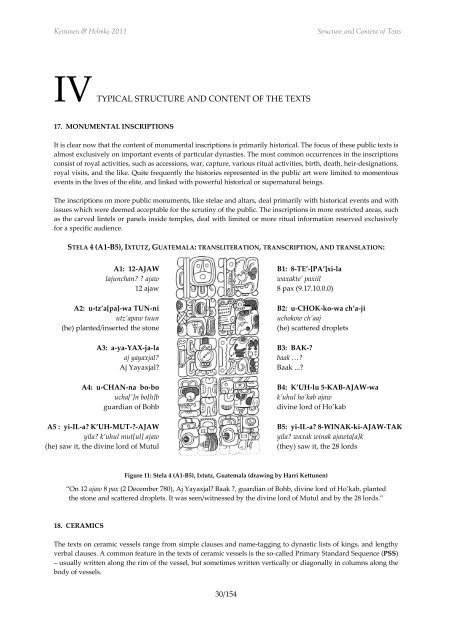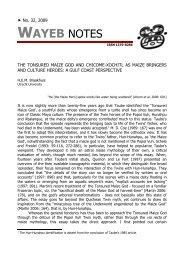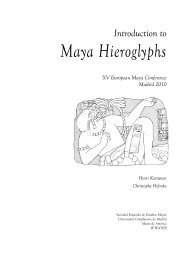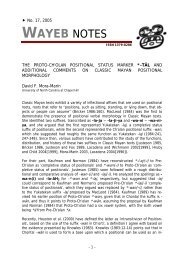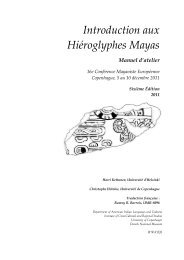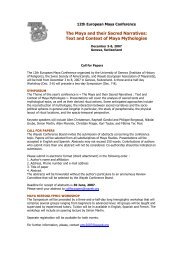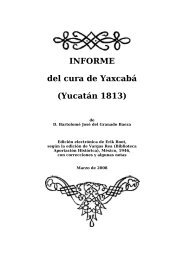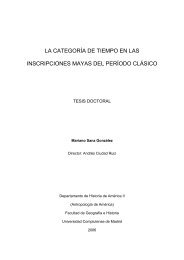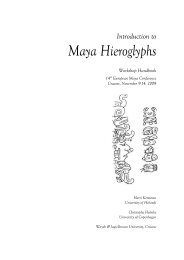Introduction to Maya Hieroglyphs - Wayeb
Introduction to Maya Hieroglyphs - Wayeb
Introduction to Maya Hieroglyphs - Wayeb
Create successful ePaper yourself
Turn your PDF publications into a flip-book with our unique Google optimized e-Paper software.
Kettunen & Helmke 2011<br />
Structure and Content of Texts<br />
IV TYPICAL<br />
STRUCTURE AND CONTENT OF THE TEXTS<br />
17. MONUMENTAL INSCRIPTIONS<br />
It is clear now that the content of monumental inscriptions is primarily his<strong>to</strong>rical. The focus of these public texts is<br />
almost exclusively on important events of particular dynasties. The most common occurrences in the inscriptions<br />
consist of royal activities, such as accessions, war, capture, various ritual activities, birth, death, heir-designations,<br />
royal visits, and the like. Quite frequently the his<strong>to</strong>ries represented in the public art were limited <strong>to</strong> momen<strong>to</strong>us<br />
events in the lives of the elite, and linked with powerful his<strong>to</strong>rical or supernatural beings.<br />
The inscriptions on more public monuments, like stelae and altars, deal primarily with his<strong>to</strong>rical events and with<br />
issues which were deemed acceptable for the scrutiny of the public. The inscriptions in more restricted areas, such<br />
as the carved lintels or panels inside temples, deal with limited or more ritual information reserved exclusively<br />
for a specific audience.<br />
STELA 4 (A1-B5), IXTUTZ, GUATEMALA: TRANSLITERATION, TRANSCRIPTION, AND TRANSLATION:<br />
A1: 12-AJAW<br />
lajunchan? ? ajaw<br />
12 ajaw<br />
A2: u-tz’a[pa]-wa TUN-ni<br />
utz’apaw tuun<br />
(he) planted/inserted the s<strong>to</strong>ne<br />
A3: a-ya-YAX-ja-la<br />
aj yayaxjal?<br />
Aj Yayaxjal?<br />
A4: u-CHAN-na bo-bo<br />
ucha[’]n bo[h]b<br />
guardian of Bohb<br />
A5 : yi-IL-a? K’UH-MUT-?-AJAW<br />
yila? k’uhul mut[ul] ajaw<br />
(he) saw it, the divine lord of Mutul<br />
B1: 8-TE’-[PA’]xi-la<br />
waxakte’ paxiil<br />
8 pax (9.17.10.0.0)<br />
B2: u-CHOK-ko-wa ch’a-ji<br />
uchokow ch’aaj<br />
(he) scattered droplets<br />
B3: BAK-?<br />
baak …?<br />
Baak ...?<br />
B4: K’UH-lu 5-KAB-AJAW-wa<br />
k’uhul ho’kab ajaw<br />
divine lord of Ho’kab<br />
B5: yi-IL-a? 8-WINAK-ki-AJAW-TAK<br />
yila? waxak winak ajawta[a]k<br />
(they) saw it, the 28 lords<br />
Figure 11: Stela 4 (A1-B5), Ixtutz, Guatemala (drawing by Harri Kettunen)<br />
“On 12 ajaw 8 pax (2 December 780), Aj Yayaxjal? Baak ?, guardian of Bohb, divine lord of Ho’kab, planted<br />
the s<strong>to</strong>ne and scattered droplets. It was seen/witnessed by the divine lord of Mutul and by the 28 lords.”<br />
18. CERAMICS<br />
The texts on ceramic vessels range from simple clauses and name-tagging <strong>to</strong> dynastic lists of kings, and lengthy<br />
verbal clauses. A common feature in the texts of ceramic vessels is the so-called Primary Standard Sequence (PSS)<br />
– usually written along the rim of the vessel, but sometimes written vertically or diagonally in columns along the<br />
body of vessels.<br />
30/154


